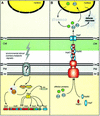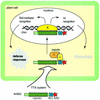Getting across--bacterial type III effector proteins on their way to the plant cell
- PMID: 12374732
- PMCID: PMC129068
- DOI: 10.1093/emboj/cdf536
Getting across--bacterial type III effector proteins on their way to the plant cell
Abstract
Pathogenicity of most Gram-negative bacterial plant pathogens depends on hrp (hypersensitive response and pathogenicity) genes, which control the ability to cause disease and to elicit specific defense responses in resistant plants. hrp genes encode a specialized type III secretion (TTS) system that mediates the vectorial delivery of bacterial effector proteins across both bacterial membranes as well as across the eukaryotic plasma membrane into the host cell cytosol. One well-studied effector protein is AvrBs3 from Xanthomonas campestris pv. vesicatoria, the causal agent of bacterial spot in pepper and tomato. AvrBs3 induces hypertrophy symptoms in susceptible plants and triggers a resistance gene-specific cell death reaction in resistant plants. Intriguingly, AvrBs3 has characteristic features of eukaryotic transcription factors, suggesting that it modulates the host's transcriptome. Here, we discuss the TTS system of X.campestris pv. vesicatoria in the light of current knowledge on type III-dependent protein secretion in plant pathogenic bacteria.
Figures



Similar articles
-
Type III-dependent translocation of the Xanthomonas AvrBs3 protein into the plant cell.Mol Microbiol. 2002 Oct;46(1):13-23. doi: 10.1046/j.1365-2958.2002.03139.x. Mol Microbiol. 2002. PMID: 12366827
-
XopC and XopJ, two novel type III effector proteins from Xanthomonas campestris pv. vesicatoria.J Bacteriol. 2003 Dec;185(24):7092-102. doi: 10.1128/JB.185.24.7092-7102.2003. J Bacteriol. 2003. PMID: 14645268 Free PMC article.
-
HpaB from Xanthomonas campestris pv. vesicatoria acts as an exit control protein in type III-dependent protein secretion.Mol Microbiol. 2004 Nov;54(3):755-68. doi: 10.1111/j.1365-2958.2004.04302.x. Mol Microbiol. 2004. PMID: 15491365
-
Type III effector proteins from the plant pathogen Xanthomonas and their role in the interaction with the host plant.J Plant Physiol. 2006 Feb;163(3):233-55. doi: 10.1016/j.jplph.2005.11.011. Epub 2005 Dec 28. J Plant Physiol. 2006. PMID: 16386329 Review.
-
Molecular secrets of bacterial type III effector proteins.Trends Plant Sci. 2001 Oct;6(10):479-85. doi: 10.1016/s1360-1385(01)02083-0. Trends Plant Sci. 2001. PMID: 11590067 Review.
Cited by
-
The coronatine toxin of Pseudomonas syringae is a multifunctional suppressor of Arabidopsis defense.Plant Cell. 2012 Nov;24(11):4763-74. doi: 10.1105/tpc.112.105312. Epub 2012 Nov 30. Plant Cell. 2012. PMID: 23204405 Free PMC article.
-
Tight regulation of plant immune responses by combining promoter and suicide exon elements.Nucleic Acids Res. 2015 Aug 18;43(14):7152-61. doi: 10.1093/nar/gkv655. Epub 2015 Jul 2. Nucleic Acids Res. 2015. PMID: 26138488 Free PMC article.
-
Mixture of Sodium Hypochlorite and Hydrogen Peroxide on Adhered Aeromonas hydrophila to Solid Substrate in Water: Impact of Concentration and Assessment of the Synergistic Effect.Int J Bacteriol. 2014;2014:121367. doi: 10.1155/2014/121367. Epub 2014 Mar 3. Int J Bacteriol. 2014. PMID: 26904729 Free PMC article.
-
Plant perceptions of plant growth-promoting Pseudomonas.Philos Trans R Soc Lond B Biol Sci. 2004 Jun 29;359(1446):907-18. doi: 10.1098/rstb.2003.1384. Philos Trans R Soc Lond B Biol Sci. 2004. PMID: 15306406 Free PMC article. Review.
-
Insights into genome plasticity and pathogenicity of the plant pathogenic bacterium Xanthomonas campestris pv. vesicatoria revealed by the complete genome sequence.J Bacteriol. 2005 Nov;187(21):7254-66. doi: 10.1128/JB.187.21.7254-7266.2005. J Bacteriol. 2005. PMID: 16237009 Free PMC article.
References
-
- Aizawa S.I. (2001) Bacterial flagella and type III secretion systems. FEMS Microbiol. Lett., 202, 157–64. - PubMed
-
- Alfano J.R., Bauer,D.W., Milos,T.M. and Collmer,A. (1996) Analysis of the role of the Pseudomonas syringae pv. syringae HrpZ harpin in elicitation of the hypersensitive response in tobacco using functionally non-polar hrpZ deletion mutations, truncated HrpZ fragments and hrmA mutations. Mol. Microbiol., 19, 715–728. - PubMed
Publication types
MeSH terms
Substances
LinkOut - more resources
Full Text Sources
Other Literature Sources

